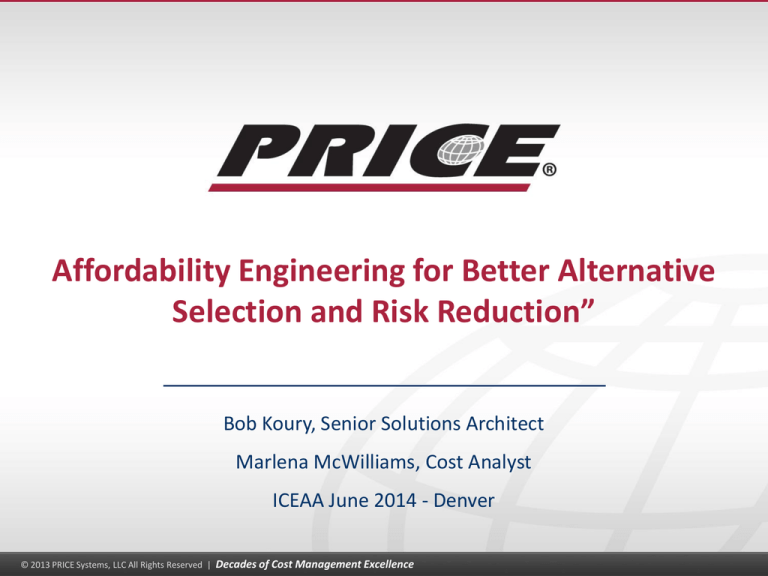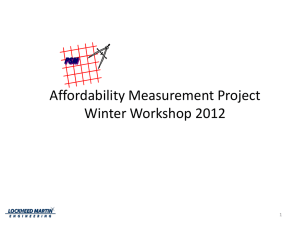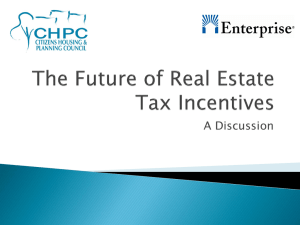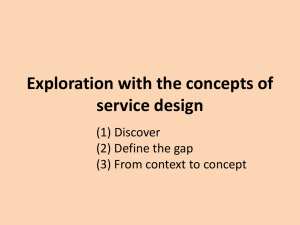
Affordability Engineering for Better Alternative
Selection and Risk Reduction”
Bob Koury, Senior Solutions Architect
Marlena McWilliams, Cost Analyst
ICEAA June 2014 - Denver
© 2013 PRICE Systems, LLC All Rights Reserved |
Decades of Cost Management Excellence
1
The Case For Affordability Engineering
“Cost, schedule, and performance problems in the Department of
Defense’s (DOD) weapon system programs are serious. Recently, we
reported that the department’s 2008 portfolio of 96 major defense
acquisition programs experienced cost growth of $296 billion,
experienced an average delay in delivering initial capabilities of 22
months, and have delivered fewer quantities and capabilities to the
warfighter than originally planned.1” Reasons for these problems
included2:
Most programs did not conduct a robust Assessment of Alternatives (AOA)
Many AOAs did not adequately assess risks for alternatives
Choosing an alternative too early and conducting AOAs under compressed time frames and without
effective guidance limit the scope and quality of AOAs.
DOD needs the ability to ensure that its [acquisition] policy changes are consistently implemented
and reflected in decisions on individual weapon system programs
Notes: 1- GAO, Defense Acquisitions: Assessments of Selected Weapon Programs, GAO-09-326SP (Washington, D.C.: Mar. 30, 2009).
2- GAO, Defense Acquisitions: Many Analyses of Alternatives Have Not Provided a Robust Assessment of Weapon System
Options, GAO-09-665 (Washington, D.C.: Sep 24, 2009)
© 2013 PRICE Systems, LLC All Rights Reserved |
Decades of Cost Management Excellence
2
Why Affordability is an SE Process
Affordability can be improved, measured and predicted
These techniques enable analysts to forecast expected
affordability of alternative technologies and systems
They allow the measurement of improvement in affordability of
a given system
The affordability trade space is composed of a relational set of
attributes that are contextually sensitive
Once this set is bounded, the need arises for an implicit
comparison to other systems, sub-systems and components.
The problem may be embedded in how systems are designed,
how they are governed, and how they are evolved. ( See Next
slide )
© 2013 PRICE Systems, LLC All Rights Reserved |
Decades of Cost Management Excellence
3
Affordability Is A Systems Engineering Metric
Affordability Analysis
is an integral part of the system engineering approach. Closely
coupled to understanding technical issues, it seeks to use a
common set of methods. Analysis can focus on the subsystem,
system, and mission levels and is performed for the entire program
life cycle. Typical products of an affordability analysis include costeffectiveness analyses, risk analyses, and total ownership cost
estimates. An affordability analysis synthesizes information from
three basic areas: mission analysis, technical analysis, and cost
analysis.”
© 2013 PRICE Systems, LLC All Rights Reserved |
Decades of Cost Management Excellence
4
Engineering Affordability Into Our Systems
Affordability Engineering is An Attitude Not A Technique
There is no formal process or technique called Affordability
Engineering but it is an inherent attribute of affordability analysis
Engineering affordability into systems and services is a team
sport requiring cooperation of:
– Program Managers
– Systems Engineers
– Cost Estimators
Engineering affordability can be an outcome of Affordability
Analysis using techniques such as:
– Value Engineering (VE)
– Design To Cost (DTC)
– Cost as an Independent Variable (CAIV)
© 2013 PRICE Systems, LLC All Rights Reserved |
Decades of Cost Management Excellence
5
How Affordability is Utilized
Determine the customer concerns and understand those
concerns
Explicit – States cost goals or operating budgets
Implicit – Inherent Relationship between performance and Cost
Compliance – Contract contains a limited budget/funding
Unit Production – Average Unit Production Cost (AUPC) goals
Total Ownership Costs (TOC)-Reduced Total Ownership Costs
(RTOC)- Life Cycle Costs (LCC) must be some determine percent
(normally 30%) less than the replaced system
© 2013 PRICE Systems, LLC All Rights Reserved |
Decades of Cost Management Excellence
6
Affordability Trade-Off Analysis
“Trade Off Analyses provide a recommended course of action with impact to
decision makers for each set of alternative examined. The impact assessment is
given in terms of cost, schedule, performance and risk/opportunity” [Note 1]
Cost Analysis
–
–
Effectiveness Analysis
–
Measures the extent to which a system
meets mission objectives
Cost
System Configuration 2
(Alternative 2)
System Configuration 1
(Alternative 1)
Risk / Opportunity Analysis
–
–
Economic consequences of an alternative
selection
Cost trade-off data provides a means to
value capability (performance),
dependability, suitability (requirements),
and cost-effectiveness
Measure uncertainity of each alternative
and their impacts in terms of cost,
performance, schedule
Measures the capacity for the system to
evolve
Benefits Analysis
–
Effectiveness
Measures the value decision makers
place on prioritized capabilities
Risk
(Opportunity)
Source: Naval Systems Engineering Guide – July 2004 (section 4.5.1 page 104)
© 2013 PRICE Systems, LLC All Rights Reserved |
Decades of Cost Management Excellence
7
Considerations of an Affordability Trade Space
23rd Annual INCOSE International Symposium - Philadelphia, PA – 24-27 June, 2013
© 2013 PRICE Systems, LLC All Rights Reserved |
Decades of Cost Management Excellence
8
Goal of Affordability Engineering
Tuttle & Bobinis (2013)
“Specifying Affordability”
23rd Annual INCOSE International Symposium - Philadelphia, PA – 24-27 June, 2013
© 2013 PRICE Systems, LLC All Rights Reserved |
Decades of Cost Management Excellence
9
Affordability Analysis Workflow
Mission –
Operational
Context
Value Framework (KPP- MOE-TPM)
Missions,
Scenarios, &
Capabilities
Needed
Completed
Iterative Cycle
Cost Analysis
Risk Analysis
Architecture
(WBS – Tech Baseline
Performance
Analysis
Schedule Analysis
Trade-Off
Analysis
Best
Value
Yes
No
Modify Baseline
© 2013 PRICE Systems, LLC All Rights Reserved |
Analyze Issues
Decades of Cost Management Excellence
Optimize tomorrow
10
3 Simple Rules For Engineering Affordability
A Life Cycle view is used for all decisions
Requirements are traded and set with a balance of cost, risk,
schedule, and performance
Risk is quantified and managed by the program
© 2013 PRICE Systems, LLC All Rights Reserved |
Decades of Cost Management Excellence
11
A Life Cycle view is used for all decision
Emphasis on Cost Objectives and Affordability
Customer-funding profile and life cycle costs
Contractor-development and production costs
User- only necessary and sufficient requirements
Cost/benefit
Development
Production
O & S, infrastructure costs
Growth & improvements
Reliability
Robust design
Supportability
© 2013 PRICE Systems, LLC All Rights Reserved |
Decades of Cost Management Excellence
12
Requirements are traded and set with a balance
of cost, risk, schedule, and performance.
Use stakeholder values to make balancing decisions
Performance-based specifications
Cost/schedule/performance tradeoffs [common trade study
process]
Requirements provide adequate utility to User (No Gold Plating)
Design meets goals set for…producibility, other “–ilities”
Decision Makers Desire
© 2013 PRICE Systems, LLC All Rights Reserved |
Decades of Cost Management Excellence
13
Risk is quantified and managed by the program
CPIPT (cost-performance IPT; User, Customer, Contractor)
AFFORDABILITY/CAIV Plan and strategy
Risk mitigation plans informed by cost targets
Organizational structure
Incentives
Cost targets
Cost reduction initiatives
KPP/TPM
IMP/IMS
Earned Value
Keep a reserve
© 2013 PRICE Systems, LLC All Rights Reserved |
Decades of Cost Management Excellence
14
Summary
Focus On Best Achievable Customer Value
Cost Thresholds
Upper
Affordability
Limit
Cost Goals
Trade
Space
What the customer
Would like to pay
Program Strategies
Mission Needs
LCC
Cost Targets
ILS
?
Customer
Operational Requirements
•Price to Win
•Optimum
Solution
•Best Bang
for the $$
•?$$?
Technical Requirements
Your mission is to make a product that meets your customer’s needs and is affordable
© 2013 PRICE Systems, LLC All Rights Reserved |
Decades of Cost Management Excellence
15
Additional Questions & Next Steps
ICEAA June 2014 - Denver
Price Systems L.L.C.
Senior Solutions Architect; US Army Programs
17000 Commerce Parkway; Suite A
Mount Laurel NJ 08054
(856) 430-6000
bob.koury@pricesystems.com
© 2013 PRICE Systems, LLC All Rights Reserved |
Decades of Cost Management Excellence
16
Definitions
Affordabillty1
The degree to which the life-cycle cost of the resources being allocated on a
capability in relation to other alternative uses of those resources reflects (i) the
importance, urgency, and satisfaction of mission, strategic investment, and
organizational needs, and (ii) a prudent balance of performance, cost, and schedule
constraints consistent with the time phased availability of budgeted resources.
Affordability Analysis
A process and assessment that supports resource decision-making which identifies
and quantifies stakeholders’ performance expectations, associates value to those
expectations, and measures the life-cycle cost of a set of alternatives in relations to
the opportunity costs of alternative resourcing actions or plan.
Notes:
1 - BusinessDictonary.com http://www.businessdictionary.com/definition/affordability.html
© 2013 PRICE Systems, LLC All Rights Reserved |
Decades of Cost Management Excellence
17
Key Techniques
Value Engineering1
Value Engineering is an organized/systematic approach that analyzes the functions of
systems, equipment, facilities, services, and supplies to ensure they achieve their
essential functions at the lowest life-cycle cost consistent with required performance,
reliability, quality, and safety
Design to Cost
Design to Cost (DTC) is an engineering discipline that meets customer cost
requirements through an iterative process that balances cost, performance, and
supportability while eliminating non-value added activity. DTC is an inherent element
of Integrated Product Development (IPD) and is implemented within the common
Integrated Product Development System (IPDS).
Cost as an Independent Variable (CAIV)
– Cost as an Independent Variable (CAIV) is a management discipline. The DOD CAIV
policy sets cost as a military requirement and requires that programs establish
aggressive, realistic cost objectives and to manage to obtain those objectives. Cost
objectives must balance mission needs with projected out-year resources. CAIV seeks
to find the optimal balance between cost, performance, risk, and schedule
Notes:
1 - DoD Value Engineering: A Guidebook of Best Practices and Tools. Retrieved May 10, 2012,
from Defense Acquisition University: https://acc.dau.mil/adl/en-US/452842/file/58455/SD-24.pdf
© 2013 PRICE Systems, LLC All Rights Reserved |
Decades of Cost Management Excellence
18









